Marrying Vega and Zen: The AMD Ryzen 5 2400G Review
by Ian Cutress on February 12, 2018 9:00 AM ESTBenchmarking Performance: CPU Legacy Tests
Our legacy tests represent benchmarks that were once at the height of their time. Some of these are industry standard synthetics, and we have data going back over 10 years. All of the data here has been rerun on Windows 10, and we plan to go back several generations of components to see how performance has evolved.
All of our benchmark results can also be found in our benchmark engine, Bench.
3D Particle Movement v1
3DPM is a self-penned benchmark, taking basic 3D movement algorithms used in Brownian Motion simulations and testing them for speed. High floating point performance, MHz and IPC wins in the single thread version, whereas the multithread version has to handle the threads and loves more cores. This is the original version, written in the style of a typical non-computer science student coding up an algorithm for their theoretical problem, and comes without any non-obvious optimizations not already performed by the compiler, such as false sharing.
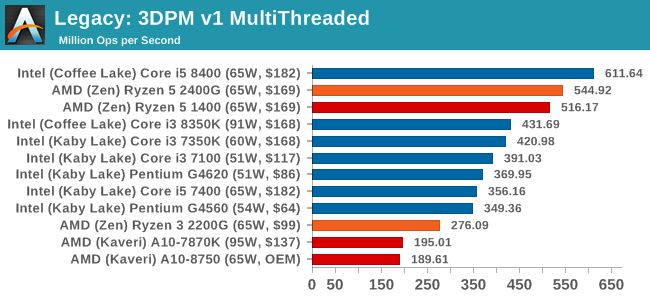
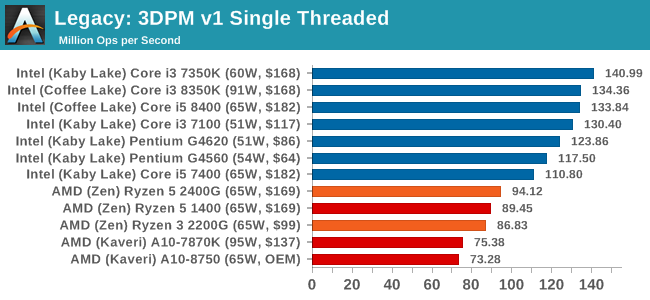
CineBench 11.5 and 10
Cinebench is a widely known benchmarking tool for measuring performance relative to MAXON's animation software Cinema 4D. Cinebench has been optimized over a decade and focuses on purely CPU horsepower, meaning if there is a discrepancy in pure throughput characteristics, Cinebench is likely to show that discrepancy. Arguably other software doesn't make use of all the tools available, so the real world relevance might purely be academic, but given our large database of data for Cinebench it seems difficult to ignore a small five minute test. We run the modern version 15 in this test, as well as the older 11.5 and 10 due to our back data.

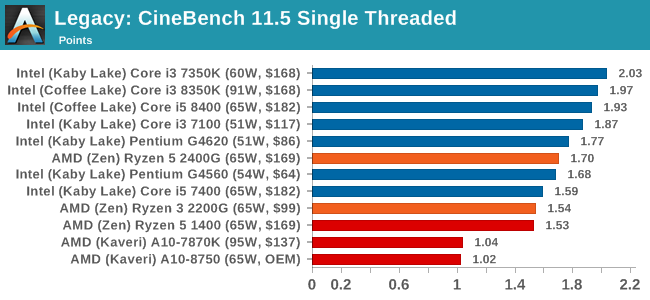
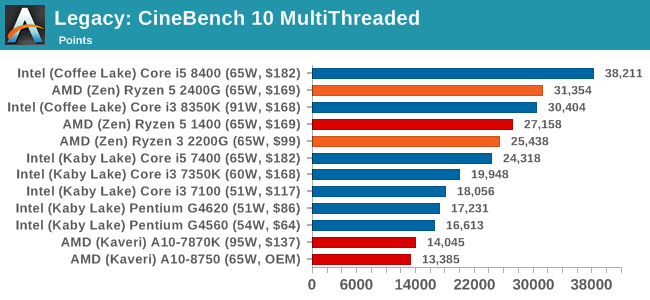
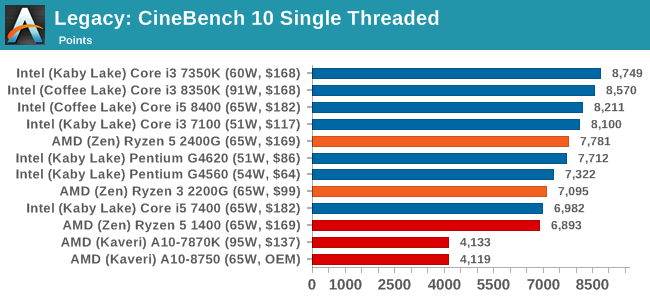
x264 HD 3.0
Similarly, the x264 HD 3.0 package we use here is also kept for historic regressional data. The latest version is 5.0.1, and encodes a 1080p video clip into a high quality x264 file. Version 3.0 only performs the same test on a 720p file, and in most circumstances the software performance hits its limit on high end processors, but still works well for mainstream and low-end. Also, this version only takes a few minutes, whereas the latest can take over 90 minutes to run.
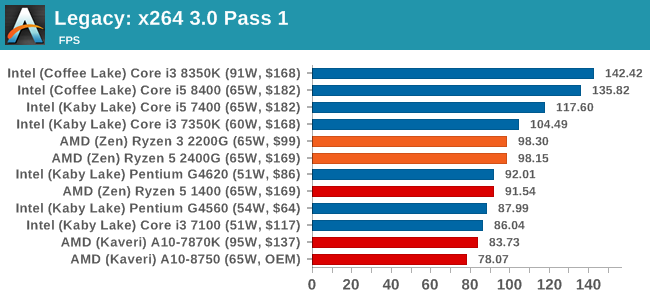
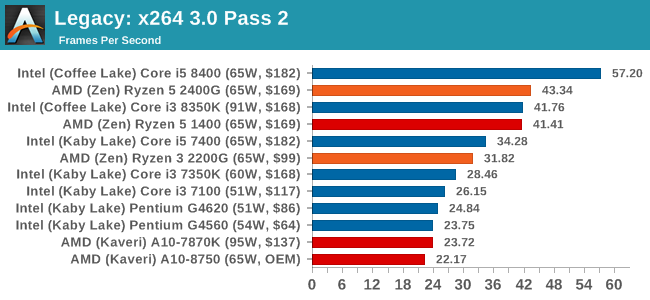










177 Comments
View All Comments
haplo602 - Tuesday, February 13, 2018 - link
Finally one review where I can see the driver version ... So this is the same driver used also for the Ryzen mobile APUs. Can you check if you can force/manual install the latest Adrenaline drivers ? That works on some of the Ryzen 2500u chips and actually increases the performance by some 15+% ...haplo602 - Tuesday, February 13, 2018 - link
I hope there's a memory scaling article in the future with frequency and CL scaling for the APU part ...crotach - Tuesday, February 13, 2018 - link
What about HTPC use?I was considering GT 1030 + Intel route for H265 and HDR10 playback and was really looking forward to Zen APUs, but there doesn't seem to be any motherboards with HDMI 2.0?!
Also, I wonder if the chips can be undervolted and underclocked to bring them to a near silent noise level for the living room.
Lolimaster - Tuesday, February 13, 2018 - link
You can undervolt and underclock ANY intel or amd cpu.forgerone - Tuesday, February 13, 2018 - link
What most writers and critics of integrated graphics processors such as AMD's APU or Intel iGP all seem to forget, is not EVERYONE in the world has a disposable or discretionary income equal to that of the United States, Europe, Japan etc. Not everyone can afford bleeding edge gaming PC's or laptops. Food, housing and clothing must come first for 80% of the population of the world.An APU can grant anyone who can afford at least a decent basic APU the enjoyment of playing most computer games. The visual quality of these games may not be up to the arrogantly high standards of most western gamers, but then again these same folks who are happy to have an APU also can not barely afford a 750p crt monitor much less a 4k flat screen.
This simple idea is huge not only for the laptop and pc market but especially game developers who can only expect to see an expansion of their Total Addressable Market. And that is good for everybody as broader markets help reduce the cost of development.
This in fact was the whole point behind AMD's release of Mantle and Microsoft and The Kronos Group's release of DX12 and Vulkan respectively.
Today's AMD APU has all of the power of a GPU Add In Board of not more than a several years back.
krazyfrog - Tuesday, February 13, 2018 - link
Why did you leave out the 8400 and the 1500X in these comparisons?Kamgusta - Wednesday, February 14, 2018 - link
Because these CPUs, while having the same price range, outperform these Raven Ridge chips. That would have been a bad press for AMD and it seems like Anandtech wants to remains extremely loyal to AMD in these days.msroadkill612 - Tuesday, February 13, 2018 - link
"the data shows both how far integrated graphics has come, and how far it still has to go to qualify for those 'immerse experiences' that Intel, AMD, and NVIDIA all claim are worth reaching for, with higher resolutions and higher fidelity. "This assumes a static situation which is rot.
what it reveals is that in the current paradigm, coders have coded accordingly for satisfactory results. If the paradigm changes and other ways work better, then code evolves.
This unprecedented integration of new gen, sibling cpu & gpu, offers many performance upsides too for future code.
picture a mobo with a discrete gpu like an equivalent 1030, then picture a ~matchbox footprint apu - there is a huge difference in the size of the respective circuits - yet they both do the same job & have to send a lot of data to each other.
it's not hard to figure which is inherently superior in many ways.
I strongly disagree with your blinkered bias.
Pork@III - Tuesday, February 13, 2018 - link
There is something unfinished, something inconsolable.elites2012 - Tuesday, February 13, 2018 - link
anything this chip lost to intel at, was most likely outdated. adobe, fcat, dolphin, pov are all outdated benchmarks.